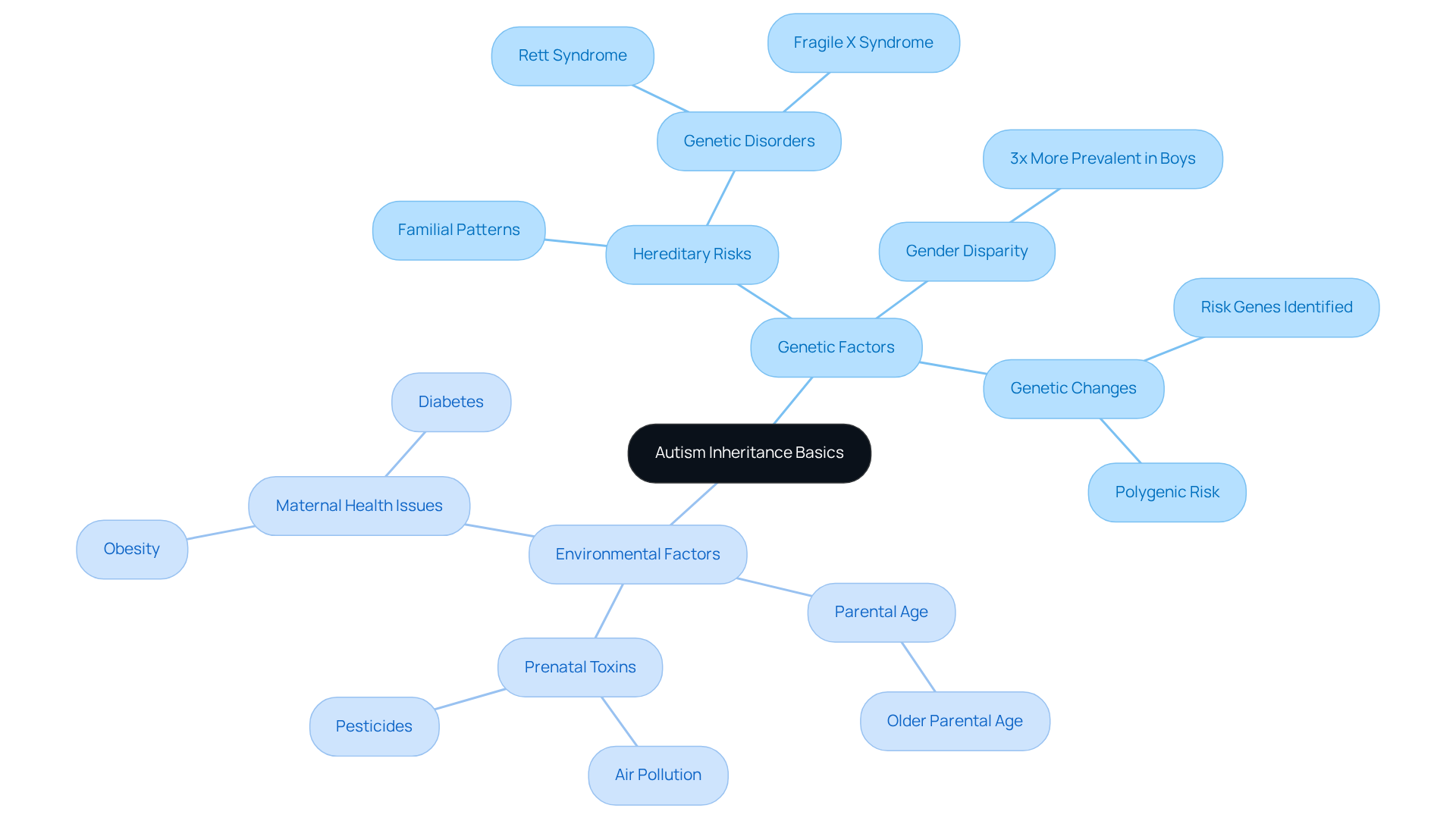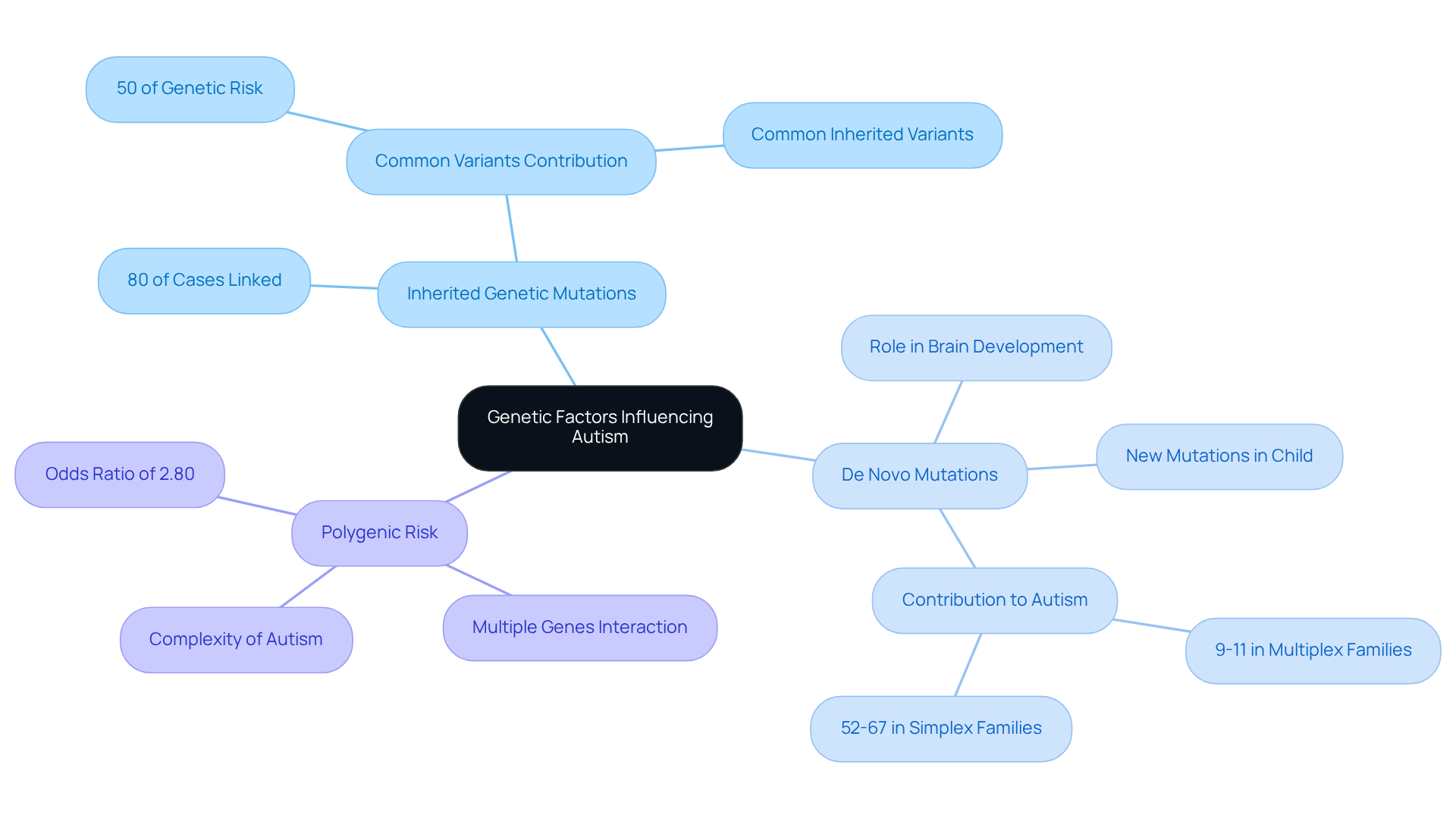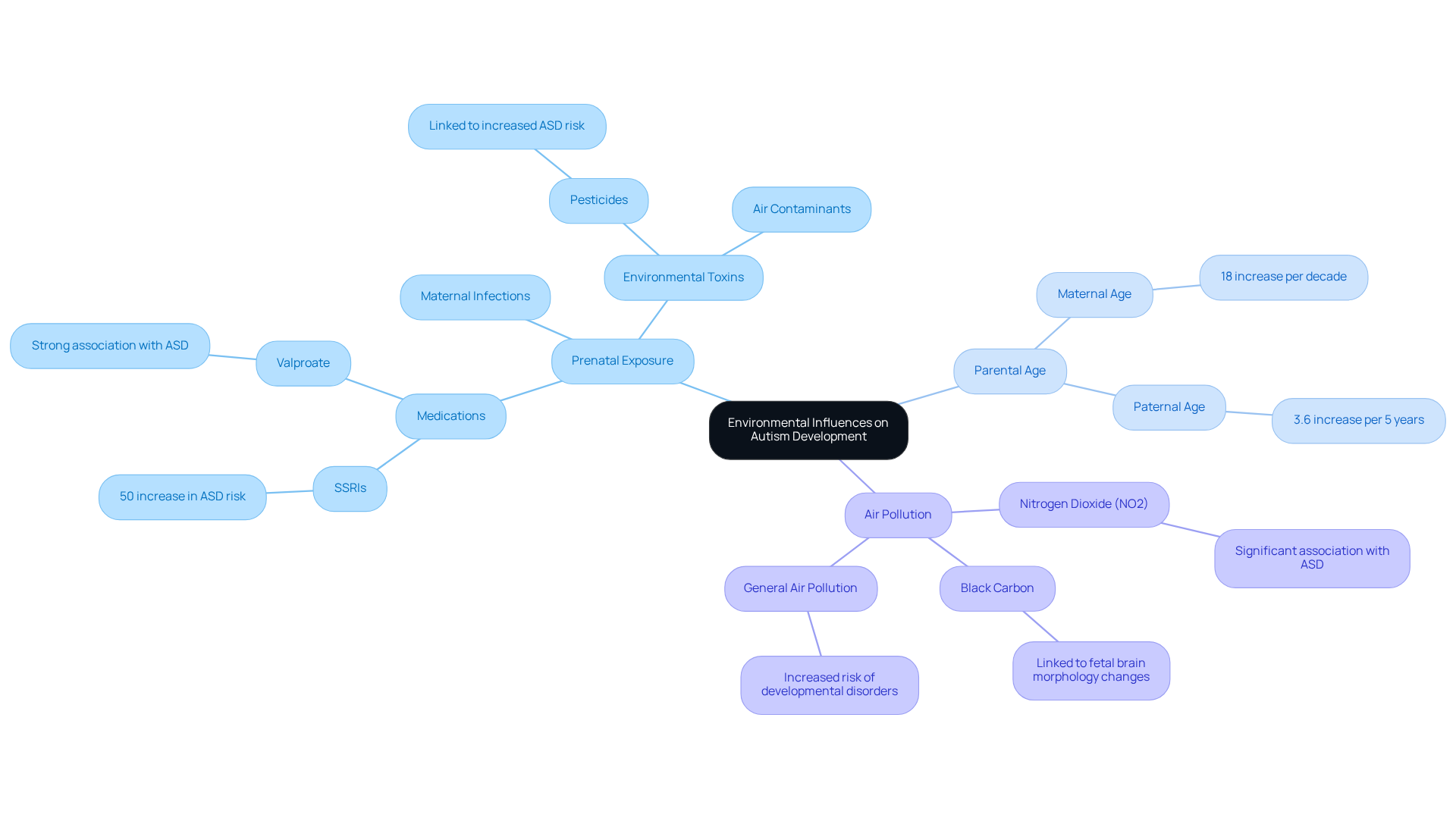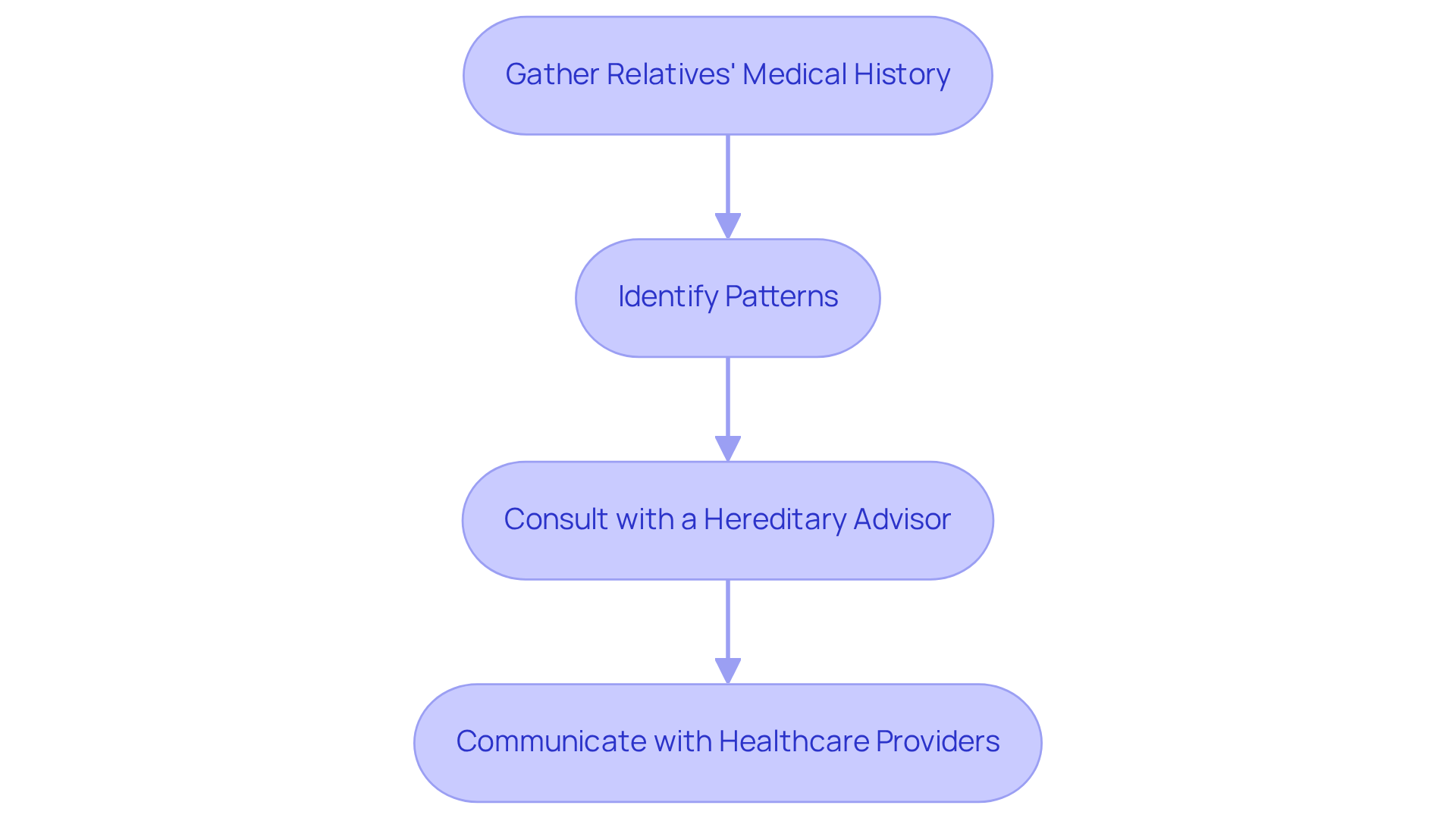Overview
Understanding autism can be a journey filled with questions and emotions for many parents. It's important to know that autism can be inherited, influenced by a combination of genetic and environmental factors. Research shows that approximately 60-90% of the risk for developing Autism Spectrum Disorder (ASD) is hereditary. This statistic highlights the significance of genetics in this complex condition.
As we delve deeper, we find that inherited genetic mutations, de novo mutations, and environmental influences—such as parental age and prenatal exposures—interact in intricate ways. These factors shape the likelihood of autism, illustrating just how multifaceted its inheritance can be. This complexity can feel overwhelming, but understanding it is a vital step in supporting our loved ones.
We encourage you to share your experiences and thoughts in the comments or through our newsletter. Together, we can foster a community that understands the challenges of autism and supports one another through this journey. Remember, you are not alone in this; there are resources and support available to help navigate these complexities.
Introduction
Understanding the intricate relationship between genetics and environmental influences in autism is crucial for families navigating this complex condition. Many parents find themselves grappling with the question of whether autism can be inherited, especially given that research indicates a significant portion of autism risk is hereditary. This concern is not just academic; it resonates deeply with families seeking answers.
However, the narrative is complicated by the interplay of genetic predispositions and environmental factors, prompting a deeper inquiry into how these elements converge. What does this mean for families yearning for clarity on autism inheritance? It invites a conversation about how they can better equip themselves to support their loved ones through this journey.
As you explore these complexities, consider sharing your experiences and questions. Together, we can foster a community of understanding and support for those navigating the challenges of autism.
Understand the Basics of Autism Inheritance
To begin with, it's essential to recognize that the question of can autism be inherited is influenced by both hereditary and environmental factors. Autism is often described as hereditary, raising the question of whether can autism be inherited, as it can run in families. Research shows that around 60-90% of the risk for developing ASD raises the important question: can autism be inherited through genetic factors? Notably, ASD is more than three times more prevalent in boys than in girls, highlighting a significant gender disparity. Furthermore, about 1 in 31 children aged 8 years has been diagnosed with ASD, emphasizing the importance of understanding this condition for families affected by it.
While genetics play a vital role, they raise the question of how can autism be inherited, yet they are not the sole contributors to the condition. Environmental factors, such as older parental age, prenatal exposure to toxins, and maternal health issues like obesity and diabetes, can interact with genetic predispositions, leading to the inquiry of whether can autism be inherited. Additionally, certain genetic changes associated with the condition can be found in individuals who do not have ASD, suggesting that the genetic landscape is intricate and nuanced.
This foundational knowledge is crucial for parents and professionals alike as they navigate the complexities surrounding hereditary conditions, including questions about whether can autism be inherited. By familiarizing themselves with these concepts, they are better equipped to make informed decisions and seek the right support. Understanding these nuances will enhance your appreciation of the intricacies related to inheritance, including the question of whether can autism be inherited and its implications for families impacted by ASD. We encourage you to share your experiences or ask questions in the comments, fostering a supportive community as we learn together.

Explore Genetic Factors Influencing Autism
Genetic factors play a significant role in the emergence of this condition, and understanding them can be crucial for families navigating this journey. Research has identified numerous genes linked to the condition, with estimates suggesting that over 200 genes may contribute to the risk of developing the disorder. Some key genetic factors include:
- Inherited Genetic Mutations: These variations are passed down from parents to children and can increase the likelihood of autism. Studies indicate that approximately 80% of cases can be associated with these inherited genetic mutations, which leads to the question of how can autism be inherited.
- De Novo Mutations: These new mutations occur in the child and are not present in the parents. They can significantly influence brain development and are thought to play a role in certain cases of developmental disorders, adding another layer to the complexity of understanding autism.
- Polygenic Risk: Autism is regarded as a polygenic disorder, indicating that several genes interact to affect the likelihood of developing the condition. This complexity makes it challenging to pinpoint a single cause, which can be frustrating for families seeking answers.
Grasping these hereditary elements is vital for caregivers and experts alike to understand how can autism be inherited. It emphasizes the intricate nature of the condition and underscores the significance of hereditary counseling for families with a background of the disorder, particularly in understanding whether can autism be inherited. By understanding these genetic factors, families can better navigate their experiences and seek the support they need.

Examine Environmental Influences on Autism Development
Environmental elements contribute to the question of whether autism can be inherited, as they play a significant role in the emergence of developmental disorders while interacting with genetic tendencies to heighten vulnerability. Understanding these influences is crucial for parents and caregivers who want to support their children effectively. Key environmental factors include:
-
Prenatal Exposure: Maternal infections, exposure to certain medications, and environmental toxins during pregnancy can negatively impact fetal brain development, potentially increasing the risk of autism. Research indicates that prenatal exposure to specific pesticides and air contaminants is linked to a higher prevalence of developmental disorders. Notably, environmental factors could influence up to 40-50% of the variance in spectrum disorder liability, and maternal use of SSRIs during pregnancy is associated with a 50% increase in the likelihood of these conditions.
-
Parental Age: The age of parents at conception also plays a role in the likelihood of developmental disorders in children. Studies suggest that the question of whether autism can be inherited relates to how genetic mutations accumulate over time, contributing to this increased vulnerability. A meta-analysis revealed that each decade increase in maternal age raises the likelihood of developmental disorders by approximately 18%. Similarly, paternal age impacts this risk, with a 3.6% increase for every five-year interval. The analysis showed a significant rise in the likelihood of developmental disorders with advancing maternal age at birth (p-value test for trend=0.02).
-
Air Pollution: Exposure to air pollution during pregnancy has been associated with a greater risk of developmental disorders. A matched case-control study found significant links between maternal exposure to nitrogen dioxide and increased susceptibility, highlighting the importance of environmental health in prenatal care. Furthermore, higher exposure to black carbon was connected to a shallower Sylvian fissure, suggesting potential impacts on brain development.
By grasping these ecological factors, caregivers and specialists can take proactive steps to minimize risks, fostering nurturing environments for children who may be vulnerable to developmental disorders. Sharing experiences and seeking support can make a meaningful difference in navigating these challenges together.

Assess Family History and Genetic Background
Understanding your ancestry is crucial for assessing the potential risk of developmental disorders in your family. Here are some compassionate steps you can take to navigate this journey:
- Gather Relatives' Medical History: Start by collecting detailed information about family members diagnosed with autism or related conditions, including siblings, parents, and extended relatives. This thorough approach helps to uncover any genetic connections. For instance, research shows that the likelihood of ASD−ID increases 16.2 times for children with at least one parent with ASD, highlighting the importance of medical history.
- Identify Patterns: Take a moment to examine your family's ancestral history for patterns. A higher occurrence of developmental disorders among relatives may indicate that the question of whether autism can be inherited is worth considering. Recognizing these patterns is vital, as family-related factors can elevate the risk of such conditions in children and lead to questions about whether autism can be inherited.
- Consult with a Hereditary Advisor: If you notice that developmental disorders are prevalent in your family, consider seeking guidance from a hereditary advisor. As Linda Ejlskov noted, understanding your ancestry can be key in assessing the risk of ASD. Genetic advisors can help evaluate the likelihood of developmental disorders in future children and explore hereditary testing options, providing valuable insights into whether autism can be inherited.
- Communicate with Healthcare Providers: Don’t hesitate to share your family medical history with your child's healthcare provider. This information is essential for making informed decisions about assessments and interventions, ensuring your child receives the right support tailored to their unique background.
By following these steps, you can gain a clearer understanding of your genetic background, empowering your family to make informed choices regarding autism risk and management. Remember, you are not alone in this journey, and seeking support can lead to a brighter path forward.

Conclusion
Understanding the complexities surrounding autism inheritance is essential for families and professionals. The interplay of genetic and environmental factors shapes the likelihood of developing autism spectrum disorder (ASD). While genetics significantly contribute to the risk, they are not the sole determinants. This multifaceted nature of autism inheritance underscores the importance of recognizing both hereditary and environmental influences in assessing potential risks.
Key insights into autism inheritance reveal that genetic mutations, both inherited and de novo, play a substantial role in the condition’s development. Environmental factors such as prenatal exposure to toxins, parental age, and air pollution further complicate the narrative. By grasping these elements, families can navigate their experiences more effectively and seek the appropriate support for their children affected by ASD.
Ultimately, fostering a supportive environment and sharing experiences within the community can empower families as they confront the challenges associated with autism. Engaging in dialogue, seeking genetic counseling, and being proactive about health can lead to better outcomes for children at risk. Embracing this knowledge not only aids in understanding whether autism can be inherited but also strengthens our collective effort to support those impacted by this condition.
Frequently Asked Questions
Can autism be inherited?
Yes, autism can be inherited, as it often runs in families. Research indicates that around 60-90% of the risk for developing Autism Spectrum Disorder (ASD) is influenced by hereditary factors.
What role do genetics play in autism inheritance?
Genetics play a vital role in autism inheritance, but they are not the only contributors. Certain genetic changes associated with ASD can also be found in individuals who do not have the condition, indicating a complex genetic landscape.
Are there environmental factors that contribute to autism?
Yes, environmental factors such as older parental age, prenatal exposure to toxins, and maternal health issues (like obesity and diabetes) can interact with genetic predispositions and contribute to the development of autism.
Is autism more common in one gender than another?
Yes, autism is more than three times more prevalent in boys than in girls, highlighting a significant gender disparity in the diagnosis of ASD.
What is the prevalence of autism in children?
Approximately 1 in 31 children aged 8 years has been diagnosed with Autism Spectrum Disorder (ASD), emphasizing the importance of understanding this condition for affected families.
Why is understanding the inheritance of autism important for families?
Understanding the inheritance of autism is crucial for parents and professionals as it helps them navigate the complexities surrounding hereditary conditions and make informed decisions regarding support and resources.




